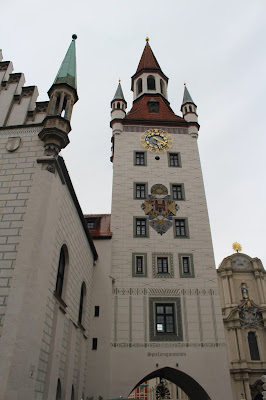Weekend in Munich
The weekend immediately after returning home for the weekend, we packed up for a quick getaway to Munich with my sister. From Kaiserslautern, we decided to drive since we were going to stay outside the city in the town called Vierkirchen. It is a four-hour drive, so perfectly doable for a weekend. There is no way to see all of Munich in one trip, and I imagine we will be back many times.
We stayed at an AirBnB apartment in a house in Vierkirchen, that was right next to the S-Bahn. It was very nice and quiet, though it was a little more of a hike to get to Munich than we had imagined. However, we were close to Dachau, which we toured on Sunday before returning home.
 |
| On the S-Bahn train from Vierkirchen to Munich Hbf |
 |
| Neues Rathaus (new town hall, 1867-1908) |
 |
| Altes Rathaus (old town hall), which now houses the Spielzeugmuseum (toy museum) |
 |
| Glockenspiel (carillon) at the Neues Rathaus, which emerges from 11:00am-12:00pm and at 5:00pm March-September |
 |
| The first round at the Viktualienmarkt |
After leaving the Viktualienmarkt, we made our way to the famous Hofbräuhaus on Platzl Square. The Hofbräuhaus is now owned by the Bavarian state government, and is famous for its one-liter (1.75 pint) Masskrug beers, giant pretzels, and lively singing.
 |
| Menu ~ Click to enlarge |
 |
| The rounds are virtually endless here, as waiters haul at least half a dozen giant beers with every pass. Women in drindls walk by with pretzels the size of your sternum, and the singing never stops |
-----Below is a summary of our time at Dachau Concentration Camp-----
The next morning, we all donned our somber caps and headed to the Dachau concentration camp memorial site. It was a trip in stark contrast to the day before, but nonetheless important to see. I didn't take any pictures while at the camp, because I personally felt it was disrespectful at the time. There are few things that make me more upset than seeing a person taking a smiling selfie at a memorial site like this. It was a day of sorrow and reflection on one of the darkest times of human history.
We parked at the camp parking lot, which cost 3 euro, and got a quick bite to eat. We ate at Mr. Tran Asia Kitchen and it was delicious; definitely the highlight of the day, and got up our strength for what we were about to witness.
The American liberators were given order to make sure the residents of Dachau and other nearby towns were forced to confront the horrors of the concentration camps. According to Harold Marcuse, in his book Legacies of Dachau, after the liberation "a group of Dachau Nazi elite was forced to tour the Dachau crematorium on 8 May 1945." While there they were made to look at the naked, emaciated bodies of the innocent victims of Nazi barbarity, piled up in the mortuary room right next to the gas chamber. Young boys in the Hitler Youth were brought to the camp and forced to look at the corpses on the Death Train.
It is a sickening sight to see. I would not recommend bringing children here until they are old enough to understand what happened here and why. Some sites (like the crematorium and gas chamber) are extremely hard for even an adult to see. I had trouble sleeping that night. As an American, I read and studied much about World War II and the Holocaust, but it is an entirely different experience to see these things in person.















Comments
Post a Comment